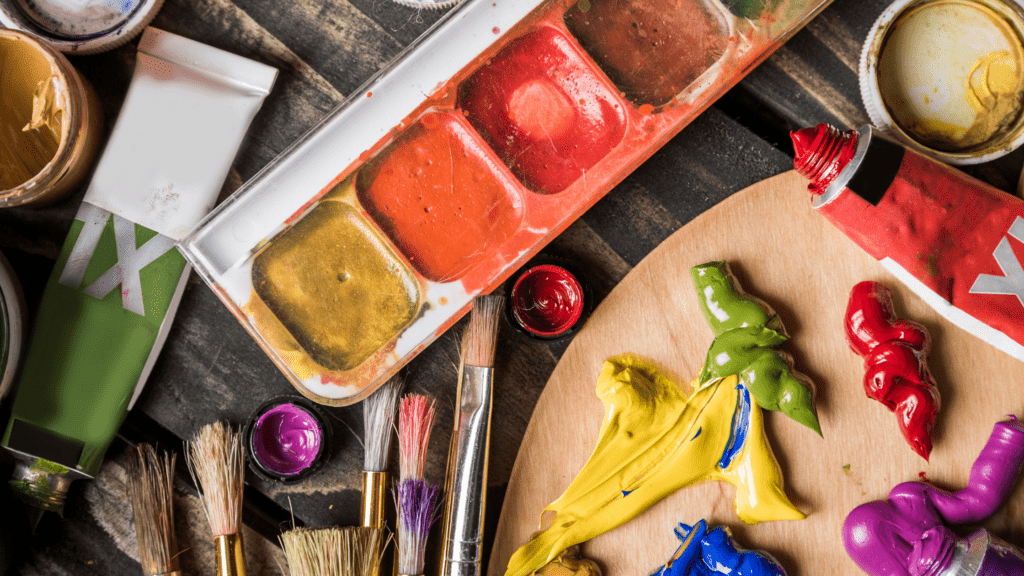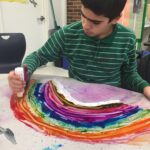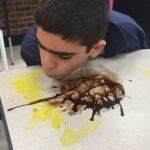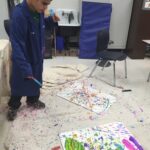By Kimberly Blecha, LCPC, ATR, CCTP
As an emerging treatment for children with autism spectrum disorder (ASD), art therapy has many benefits for this population, including components of sensory stimulation, kinesthetic engagement, and an opportunity for growth. Art, as a developmental tool, can explore and provide evidence of development within the child as well by analyzing drawings and noticing changes over time.
Art therapy can be viewed through two different lenses as seen in the image below: Art as therapy and art psychotherapy. Art as therapy looks at the physical process of engaging in art as a therapeutic tool. Art as a tool can be relaxing, soothing, and helpful in regulating an individual. Art therapy is oftentimes the focus when working within the special education field. However, this does not mean that, while engaging in art to help regulate an individual, provide an outlet for self-expression, or just as a leisure activity, that there is not a therapeutic benefit to it.
Art psychotherapy, on the other hand, focuses on the traditional talk therapy in which a client works through inner struggles, resolves conflicts, expresses themselves, and works through trauma, but it uses art as an avenue for bringing these things to light. The art product becomes a tool for the therapist to understand what the client is thinking and feeling.
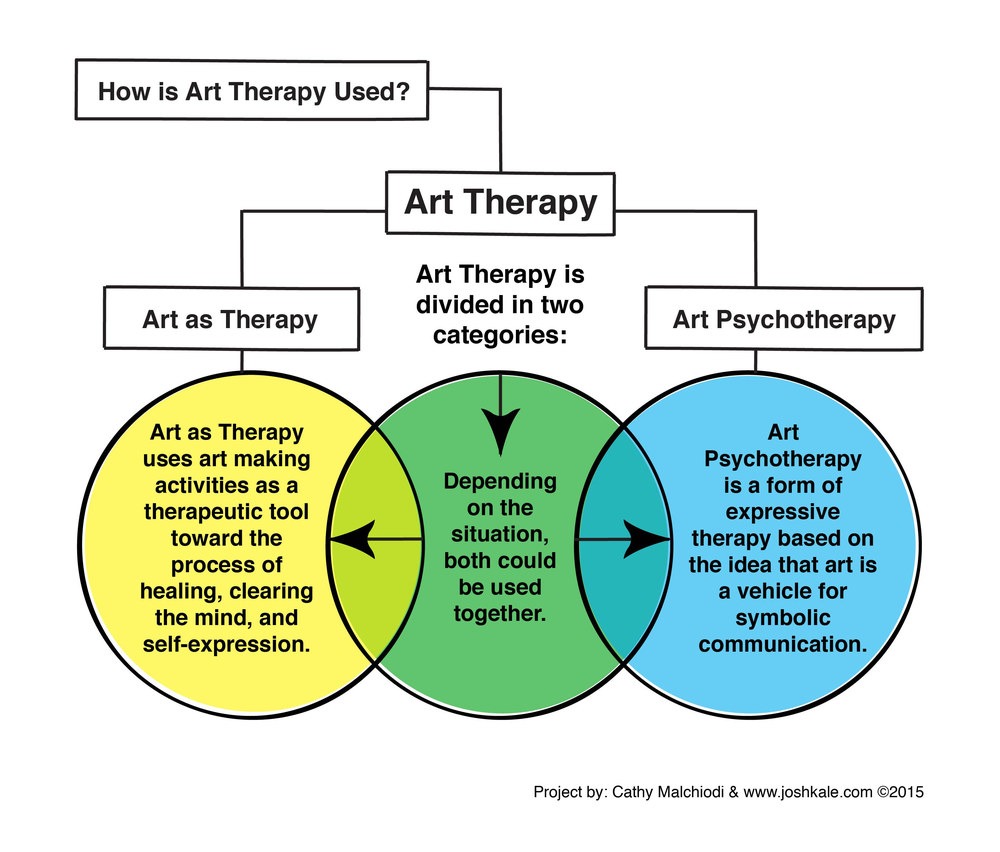
Art therapy offers a myriad of therapeutic possibilities. It helps with self-regulation, self-expression, creativity, independence, self-advocacy, fine motor skills, functional skills, and more. And how can art therapy possibly do all this? Let me explain.
Art as a Form of Self-Expression
Art therapy begins with the basic understanding that art is a form of self-expression. It is a self-expression that uses colors and shapes instead of words. As Georgia O’Keeffe, an American modernist artist said, “I found I could say things with color and shapes that I couldn’t say any other way – things I had no words for”. A common characteristic with autism spectrum disorder entails problems with social interaction and communication. This can include little to no eye contact, delayed speech, preferring to play alone, repetitive speech, struggling to initiate conversations, problems expressing their own feelings, or understanding the feelings of others. Art therapy not only provides an avenue to communicate, but it also can be the ignition for starting a conversation or encouraging self-expression, as well as an avenue for expressing frustration.
Even for the neurotypical population, if an individual has not succeeded in traditional talk therapy, art therapy can provide a path to start the process of growth. The art piece essentially becomes the starting point for further discussion with a therapist.
The Expressive Therapies Continuum
How does art therapy promote the development of all the above-mentioned skills? Art therapy works on a continuum. What has come to be known as the Expressive Therapies Continuum, or ETC, was initially proposed and published in 1978 by art therapists Sandra Kagin and Vija Lusebrink. As you can see from the diagram below, the continuum at its foundation focuses on the kinesthetic and sensory experience of art. When working with the special education population, students who have lower cognitive abilities, lower IQs, and comorbid disorders such as ADHD, depression, or anxiety, etc., the ETC is where a lot of foundational, productive work can occur in art therapy. While this continuum is usually used throughout a person’s life as they develop and age, the goal is to eventually achieve the cognitive and symbolic level of the ETC. For the ASD population, this can be hard to accomplish in the definitive sense of a client’s ability to process through their art piece with a therapist. However, the inner balance can still be achieved at any level.

Art Therapy and Special Education
I had the wonderful opportunity to use art therapy with the students here at Little City in my first job out of graduate school, and I focused a lot on the sensory and kinesthetic aspects of art. Not only do students with ASD engage in repetitive patterns of movement such as rocking, spinning, or hand-flapping; they also may be unusually sensitive to sensory experiences such as texture, temperature, and consistency. Providing art therapy to this population helps ease some of the stigma around these symptoms of autism and implores the students to embrace their symptoms to create works of art.
As a tool within the special education field, art therapy can be used in many ways the average person may not even consider. When used individually, it can be a tool to help a student reach a goal of self-advocacy by requiring the student to ask for help when they run out of things like paint or glue, or when their favorite color isn’t on the table. For many students, hearing the word ‘no’ can be an immediate trigger for maladaptive behaviors such as physical aggression, verbal aggression, or property destruction. Within art therapy sessions, the therapist can work with the client through the emotions that come with being told something is unavailable to them, while doing so in a safe space with a trusted adult and support from other professionals.
One thing I have learned from my time here at Little City is how important offering choices is to this population. Whether verbal or not, it is important to allow students the opportunity to express themselves and their likes or dislikes by allowing them to choose the materials they wish to use in session. It may come down to something as simple as the color paint they use, or as complex as a particular magazine page they want to use in a collage piece. Giving over the power to the student to choose what they want to work with helps to empower them not only in session, but throughout their entire life as well.
Art Therapy and Sensory Integration
Art therapy also works on a continuum that address the malleability of the medium. For students with certain needs, whether they might want a structured project, simpler materials, etc., this continuum can be used to see if the media meets the student at their present level of functioning. You can also move students up and down the continuum to expose areas they may struggle with, thus opening them up to new experiences and opportunities for growth.

As mentioned earlier, this population often struggles with sensory sensitivity. For some, it can be debilitating and can interfere with their functioning. From not being able to eat certain types of food, or not being able to wear certain types of clothes due to tags, sensory sensitivity is prevalent with this population. Trying new things is hard for everyone but can be even harder for our students. Art gives the opportunity to slowly desensitize our students to specific textures and consistencies. In fact, more often than not, I have found sensory art to be the most favored by students. This may include shaving cream art, in which shaving cream becomes the paint; Kool-Aid painting, in which the sense of smell is brought to the forefront; painting with bubble wrap and utilizing the physical component of the bubble wrap to explore with texture; or magazine collages in which tearing up paper is not only allowed but preferable!
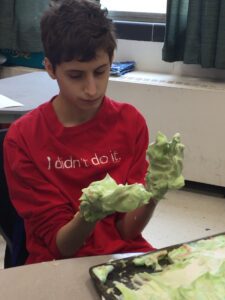
Student, Joseph N. engaging in art therapy, exploring the sensory components of the shaving cream.

Methods of adapting painting for those students who do not like to get their hands dirty. Primary colored paint in plastic bags, taped to the table. Students are able to mix the colors together to make a new one, without having to get their hands dirty!
All these art processes help to aid the individual in not only coming face to face with sensory components, but being able to work through the hesitation that may come from the unknown about how cold the shaving cream may feel, how strong the Kool-Aid smell is, or how the act of ripping paper sounds. With new advances in technology, art can now also be explored on tablets like iPads. For some students who have aversions to getting dirty, or do not like the feel of art materials, there are countless coloring and art creation apps that allow the student to express themselves without any of the mess. This is a great way to ease a student into the art-making process.
Art Therapy and its Use in Special Education Related Services
Not only does art therapy help with sensory experiences, but it also pulls in other related services such as speech therapy and occupational therapy. In recent years there has been a push for more adaptive and inclusive art tools. Art adaptations can be broken down into four major categories:
- Adaptations in the physical environment
- Adaptations in the art media and tools
- Adaptations in the instructional sequencing
- Adaptations in technology
Certain changes to the environment such as playing music in the background or using tools like tabletop scissors, weighted paintbrushes, tap glue, and slant boards are the first steps to modifying art to meet the needs of the students. In addition, using gestural, verbal, or physical prompts and having example artwork can be beneficial for some students.
These adaptations allow students with deficits in fine motor skills the ability to participate in art. Not only is art becoming more inclusive, but it also allows for co-treating with occupational therapists when it comes to working through those fine motor deficits. Something as simple as holding a paintbrush or squeezing a glue bottle can be a year-long goal that art therapy and occupational therapy hope to achieve together. One of the most successful art therapy groups I led was a watercolor squirt gun painting group and having the aid of an occupational therapist really helped to allow students with even the faintest finger grip to participate and enjoy it. When you think of the amount of hand-eye coordination it takes to do something as simple as putting paint on a paintbrush, it really helps to put into perspective how hard this may be for someone who struggles with fine motor skills and coordination.
On the other side of the table is speech therapy. Not only does art therapy provide a talking point for a session based on the art directive, but it can also be as simple as giving the student the opportunity to use their AAC (Augmentative and Alternative Communication) device to ask for the color marker they want. There are a lot of individual choices that are asked of students in art therapy, and together with the speech therapist, the student can learn the skills to communicate with others. When in groups, art therapy can also open up the line of communication with peers, in which a student can use their voice, AAC device, or visuals to comment on or praise a peer for a completed project.
Social communication, which is a struggle for those with autism spectrum disorder, can also be fostered within art therapy groups. Something as simple as having only one bottle of paint requires students to share and ask each other to pass the paint. Or in partner painting, two students work on the same sheet of paper and the art therapist can help set up communication opportunities as part of the process. Working in a safe space with trusted professionals, students can work on their communication skills during a preferred activity.
An Unexpected Artist Emerges
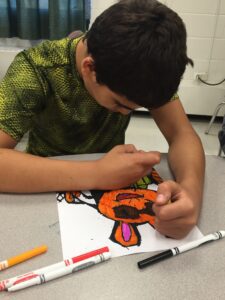
Student, Johnny U. who was stuck in his rigidity and attention to detail
While working as an art therapist at Little City, I had one student who was an excellent artist. He could copy just about anything he laid his eyes on. He was verbal, but oftentimes spoke in scripts, unless requesting a preferred item. He would copy things to the very last detail. While it was wonderful to see his attention to detail, I soon learned that it was oftentimes creating an aura of anxiety around him, in which he was afraid to miss something. This was a student for which the product overshadowed the process. His pride was often only apparent after a project was completed and it looked exactly like any example I had made. I began to see this was a student in individual art therapy sessions where we focused on decreasing his anxiety and need for perfection. I had heard from his teacher that he was going through a box of markers every day because he only liked his coloring pages filled in with markers when they were brand new and the color was just right. This is a student who often engaged in physical aggression when he became dysregulated, and this happened often when brand new markers were not always at his disposal.
While his classroom team was working with him to help him regulate, I also was working with him within sessions on coping skills when things didn’t go his way. We began to explore with art materials that were less rigid and required him to move outside of his comfort zone.
Student, Jonny U. who began to explore with other forms of art with the use of fluid materials, like using watercolors to blow a cool design across the table (this was completely impromptu after finishing another art project!), dot stampers, technology and gross motor movement
He quickly took to some sticker art I offered, where the format was color by sticker instead of color by number. Each sticker matched a number on the coloring sheet and when all the stickers were on, an art piece came to life. Ater realizing how much this student liked this activity, I began to think of ways in which to use it to help him work on skills like flexibility. While in the safe space of the session, I would start to make certain stickers unavailable to him. This would give us the opportunity to work together to problem solve and devise a solution that did not include resorting to property destruction or physical aggression.
For multiple sessions we worked through the initial surprise of a sticker being missing, the anxiety that ensued, and then the problem solving that needed to occur. Slowly but surely, this student began to not only accept when a sticker was missing but began to problem solve on his own, going and getting construction paper that matched the surrounding color, and cutting it out to match the sticker shape, and then gluing it on in place of the sticker.
The first time this student did this independently, a tear came to my eye. What I was experiencing was not the success of art therapy in the traditional sense; it was the success of using art as therapy in a way that encouraged this student to not only be flexible, but to take a deep breath, regulate his emotions, and problem solve for himself. The success from these sessions also translated to the classroom where this student would no longer resort to aggressive behavior when his markers dried out; instead, he would ask for other materials like crayons or paint. Or he would problem-solve and try to dip the marker in water to make the marker last longer. He began to accept that brand-new markers were not always going to be an option, and he found other ways to engage in the art process. This was not an easy fix and took almost a year to accomplish. While this student has since moved on from Little City, I think about him often and hope that wherever he is, his time with me allowed him the chance to learn to be a little bit more flexible, and problem solve for himself a little bit more. To this day, I still have one of his iPad art projects printed and laminated and hung on my office bulletin board, as it serves as a gentle reminder of the power of art therapy.
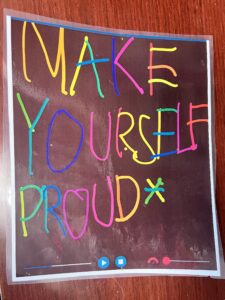
The Beauty of Art Therapy Beyond Just the Students
One of the hardest things I had to learn as an art therapist here at Little City, was to be open and flexible when things didn’t go according to plan. When I look back at it, this is quite ironic, because, while flexibility is a trait that many with ASD do not have, they sure did teach me a lot about it! Some of my most successful art therapy sessions came from embracing the moment and being adaptable. Even when planned projects fell through, or student engagement was minimal, sometimes all I had to do was clear off the tables, lay out some paint, roll up the sleeves, and let the students get to work. Not only did they teach me to be flexible; they taught me that it really is the process and not the product.
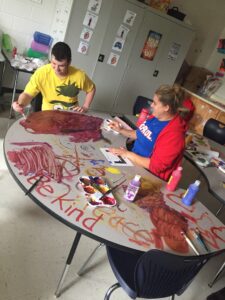
Art therapy is a beautiful thing, but something I never saw coming was its ability to reach not only the students but the staff as well. In group therapy, I often found myself reminding the staff that the project was for the student and not for them! However, I also saw the therapeutic benefits it had on the staff. Stress levels decreased, communication became more effective, and self-expression thrived. Working in a therapeutic day school is hard and can be very stressful, so I found little ways to help the staff. I started having extra projects on the side for staff to complete, and I started leaving paint out at the end of the day and asking for staff to help clean up the art room with me. However, instead of cleaning, I gave them the tables as open canvases to paint on. Initially one or two people would stop by after art therapy days, but gradually more and more staff joined in. Oftentimes I would just sit back at my desk and let them talk, vent, problem-solve, etc. What art therapy gave them was a safe place to express themselves, work through the day’s struggles, and leave regulated and refreshed for another day.
While I am no longer an art therapist here at Little City (I have since taken on the role of School Clinical Coordinator), I still promote the use of art with the school staff. In my office I have what is called a Buddha Board, which you can paint on with water, and as time goes by, the water dries and starts to fade away, leaving the artist with a new blank canvas. The Buddha Board’s tagline is “the art of letting go”. At a job in which things often do not go according to plan, with students who struggle with physical aggression, property destruction, self-regulation, and emotional regulation, this Buddha Board in my office allows staff a safe place to express themselves. You do not need to be a good artist to benefit from watching the day’s struggles slowly fade away as you yourself are able to regulate.
The Original Buddha Board – Relaxing Water Drawing & Painting
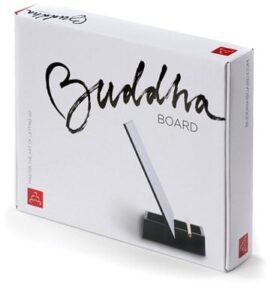
Whether used as a tool by a student to express their frustration, demonstrate fine motor skills, or simply engage with art as a leisure activity, art therapy provides a path for increasing so many skills that the autism population struggles with. At the foundation, art is a process. It is a lifelong tool that anyone can use. There are no parameters to art, no rules, no expectations, no judgment.
Kimberly Blecha, LCPC, ATR, CCTP is the School Clinical Coordinator at Little City Foundation’s ChildBridge Center for Education.
